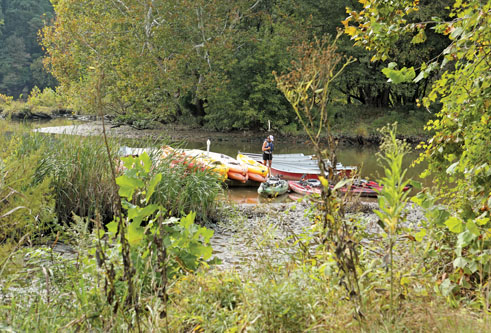City to Study Options for Fletcher’s Cove Sediment

By Zoe MorganCurrent CorrespondentAmid concerns that sediment buildup could imperil Potomac River access at Fletcher’s Cove, the D.C. Department of Energy & Environment is taking early steps toward dredging the riverbed at the popular boat launch.Located near the corner of Reservoir and Canal roads NW, Fletcher’s Cove serves an estimated 100,000 people per year for river access, according to the park’s friends group. Mike Bailey, the organization’s spokesperson, said he estimates that ongoing sediment buildup would consistently prevent watercraft from entering the Potomac via Fletcher’s Cove within three to six years.“To lose that access would cut off many thousands of people who enjoy the resource,” Bailey told The Current.Although the city’s environment department hasn’t conducted a study of the sediment’s effects at Fletcher’s Cove, the agency’s Daniel Conner said in an interview that it is already evident that access is becoming increasingly limited.“I see Fletcher’s Cove as a major access point to the Potomac River, and [it] provides recreation to so many people on a yearly basis,” Conner said.Sediment has built up because an area of manmade land blocks the natural flow of the river from flushing out the cove, Bailey said. In the 1960s, when a sewer system was being dug nearby, excavated debris was dumped near the cove — which has allowed sediment to build up ever since.Two prior dredgings have taken place, one in the 1980s, and another in the 1990s. However, according to Conner, information about those projects is sparse. Periodic dredging will continue to be necessary as long as the manmade land remains in place, Bailey said.The first step is to test the soil and sediment for any contaminants, for which the Department of Energy & Environment has set aside $150,000. The agency is currently reviewing bids and plans to award the contract in early 2018. The actual testing will take a month, Conner said.“The first step was to say, ‘OK, what’s in the sediment and what’s in the soil?’” Conner said, “which will determine what you can do with the sediment. So, can you take the sediment and compact the parking lot of Fletcher’s Cove? Or does this have to be hauled off to the landfill somewhere? Or can it potentially be used in another project?”The cost of the dredging itself is dependent on the character of the sediment, although it is estimated to be between $1 million and $3 million, Bailey said. The most expensive part of the process is hauling away the sediment after it is dug out. The city has not set aside funds to cover the dredging, and the friends group is in the process of doing fundraising.After dredging is complete, the process of getting approval for removing the manmade land could begin, although there isn’t yet any cost estimate for that project, Bailey said.The cove, located between Chain and Key bridges in the C&O Canal National Historical Park, is a popular spot for fishers, canoers and kayakers, among other recreational uses. The National Park Service installed a floating dock there in 2015, resolving concerns about an unsafe walkway that threatened the site’s spring opening that year.This article appears in the Oct. 11 issue of The Georgetown Current newspaper.




